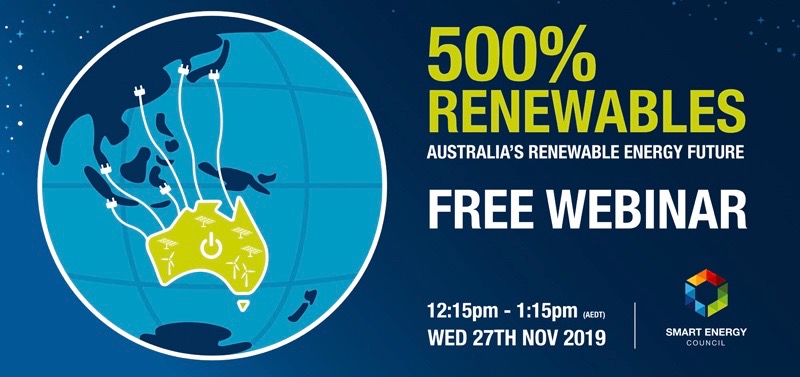In a recent webinar hosted by the Smart Energy Council (SEC), SEC CEO John Grimes was joined by former Clean Energy Finance Corporation (CEFC) and current CEO of Bronze Boar investments, Oliver Yates. Yates has long been alone in his belief that 500% renewables in Australia is eminently achievable, now others are joining him in the call, including Australia’s chief scientist Alan Finkel who recently spoke of Australia’s 800% renewable opportunity.
For many, the concept of even 100% renewables is teetering on the verge between optimism and delusion, but Grimes reminds us that this is a hangover idea from the 1970s, 80s and 90s, a myth, a lie that renewables are not reliable and too expensive. As Grimes notes, “these ideas have not kept pace with the reality of technology and energy economics.”
Grimes recounted a recent visit he took to ITP Renewables whose openCEM (a free, open-source, Capacity Expansion Model) demonstrates that 100% renewables can by delivered by 2050, despite current government inaction at the federal level. Moreover, openCEM not only predicts that the country can reach 100% renewables by 2050 with 99.98% availability (same as the current grid) utilising pumped hydro, battery storage, solar thermal etc., but that the price per megawatt would be $13 cheaper per hour than we pay today. “Not only do we have the technology,” said Grimes, “but we can actually deliver sustainable, reliable energy cheaper.”
However, this prediction is purely looking at stationary energy in Australia. The reality is so much more extensive, including the electrification of other industries and manufacturing, and of course, renewable energy exportation. With Australia’s competitive advantage, 500% renewables is by no means an outlandish suggestion.
Yates’ 500% renewable confidence is not unfounded. Not only does the former CEFC CEO remember the kind of denialism that has dogged (and been overcome), by the renewable transition for decades, such as that renewables would require subsidisation in perpetuity or that Australia would never reach its Large-scale Renewable Energy Target (LRET) by 2020. Of course, renewables are now cheaper than fossil fuels and LRET was met more than a year in advance. “Costs continue to decline,” says Yates, “every year we are seeing improved price points, and clearly a price for renewables of $35-40 MW/h is within vision.”
Every time renewables have been doubted, they’ve proved the doubters wrong. Now, Yates contends, the nation has a golden opportunity to reindustrialise using renewable energy sources. With the adoption of the new National Hydrogen Strategy, this renewable reindustrialisation is underway. After all, if we are to export “one million tonnes of hydrogen per annum”, Yates predicts, we will “require the construction of 23 GW of new renewable capacity.”
Of course, there are many, and not without good reason, who doubt whether hydrogen is a viable export opportunity for Australia considering its round-trip efficiency and the distance of potential trading partners (Japan, South Korea). Indeed, according to Andrew Blakers, of the Australian National University’s (ANU) School of Engineering and Computer Science, while hydrogen may furnish domestic energy supplies, and potentially power shipping, as an export in itself hydrogen’s “woeful round-trip efficiency” renders it unviable.
However, Yates argues that we need to better understand that “hydrogen is just an indicator of the path we’re on.” That we could utilise one million tonnes of clean hydrogen to reindustrialise our domestic and for-export ammonia industry (an 800 million tonne global industry). This is just one industry, there are many others which hydrogen could clean up in the time it will take for technological advance to render direct hydrogen exportation viable.
“Australia missed the dotcom-boom,” said Yates, “but we can’t miss the clean energy boom…We can become a smart, reindustrialised and reinvigorated nation.” Not only is 500% renewables achievable, but considering the scope of industries that renewables can transform in Australia, 500% is a “walk in the prosperous park for Australians.”
With Australia’s undisputed competitive advantage in renewable energy the matter is really down to us. It’s Field of Dreams situation, if we can build it (reindustrialise with renewables), they will come (export partners).
This content is protected by copyright and may not be reused. If you want to cooperate with us and would like to reuse some of our content, please contact: editors@pv-magazine.com.









1 comment
By submitting this form you agree to pv magazine using your data for the purposes of publishing your comment.
Your personal data will only be disclosed or otherwise transmitted to third parties for the purposes of spam filtering or if this is necessary for technical maintenance of the website. Any other transfer to third parties will not take place unless this is justified on the basis of applicable data protection regulations or if pv magazine is legally obliged to do so.
You may revoke this consent at any time with effect for the future, in which case your personal data will be deleted immediately. Otherwise, your data will be deleted if pv magazine has processed your request or the purpose of data storage is fulfilled.
Further information on data privacy can be found in our Data Protection Policy.